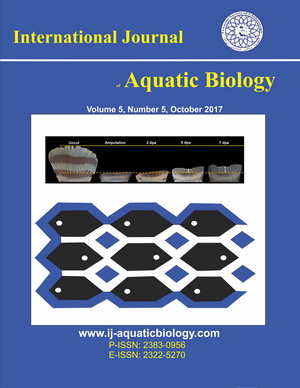Influence of continuous illumination at increasing light intensities on the growth and survival of early stage Snubnose Pompano, Trachinotus blochii
Downloads
The study investigated the influence of continuous illumination at increasing light intensities on feeding, growth, and survival of early-stage snubnose pompano,Trachinotus blochii, larvae from 1 to 10 days post-hatching (DPH). Fish larvae were exposed to 5 treatments with 3 replicates [T1 - natural indoor 12 hours light (hL): 12 hours dark (hD), T2 - 300-500 lux (lx), T3 - 300-1000 lx, T4 - 300-2000 lx, and T5 - 300-3000 lx]. Newly hatched larvae were stocked at 15 ind. /L density and fed with enriched rotifers (Brachionus plicatilis; 50-250 µm) at 30 ind. /ml starting from 2 DPH. The number of rotifers in the digestive organ, feeding incidence, and total length of larvae were examined at 3-hour intervals from 0400 to 2200 hours (H) on 3 DPH, at 6-hour intervals from 4 to 5 DPH, and once on 8 DPH at 1000 H. The results justified that snubnose pompano was a visual feeder and exhibited diel rhythm within 24 hours of light, while larvae at natural photoperiod usually underwent diurnal rhythms. However, changing light intensity conditions from low to high levels altered the feeding behavior of the fish larvae. Better and consistent feeding and survival of larvae were obtained at moderate continuous illumination at increasing light intensities (300-500 lx). While higher light treatments (300-1000, 300-2000) can yield more remarkable fish growth, they adversely affect larval survival after 5 DPH. In conclusion, moderate continuous illumination (300–500 lx) promotes consistent feeding, resulting in a positive growth response and improved survival in early-stage snub nose pompano.
Downloads
Abdollahpour H., Falahatkar B., Lawrence C. (2020). The effect of photoperiod on growth and spawning performance of zebrafish Danio rerio. Aquaculture Reports, 17: 100295.
Alejos M.S., Serrano Jr. A.E. (2018). Continuous illumination improves growth and survival in the early stage of snubnose pompano Trachinotus blochii. Aquaculture, Aquarium, Conservation and Legislation, 11: 1557-1563.
Alejos M.S., Jumah Y. U., Serrano Jr. A.E., Laureta L.V. (2019). Effect of different satiation level on the growth and survival of Nile tilapia Oreochromis niloticus L. under continuous illumination. IOSR Journal of Agriculture and Veterinary Science, 12: 15-20.
Alejos M.S., Serrano Jr. A.E. (2024). Effect of Photoperiod on the Growth and Survival in the Early Stage of Snubnose Pompano Trachinotus blochii. In: Innovations in Biological Science (Hussain, I), Vol. 3. B P International. pp: 01-11.
Al-Emran M., Zahangir M.M., Badruzzaman M., Shahjahan M. (2024). Influences of photoperiod on growth and reproduction of farmed fishes - prospects in aquaculture. Aquaculture Reports, 35: 101978.
Arambam K., Singh S.K., Biswas P., Patel A.B., Jena A.K., Pandey P.K. (2020). Influence of light intensity and photoperiod on embryonic development, survival and growth of threatened catfish Ompok bimaculatus early larvae. Journal of Fish Biology, 97: 740-752.
Churova M., Shulgina N., Kuritsyn A., Krupnova M., Nemova N. (2019). Muscle specific gene expression and metabolic enzyme activities in Atlantic salmon Salmo salar L. fry reared under different photoperiod regimes. Comparative Biochemistry and Physiology Part B, 239: 110330.
Falahatkar B., Bagheri M., Efatpanah I. (2019). The effect of stocking densities on growth performance and biochemical indices in new hybrid of Leuciscus aspius ??×?Rutilus frisii ?. Aquaculture Reports, 15: 100207.
Lundova K., Matousek J., Prokesova M., Sebesta R., Policar T., Stejskal V. (2019). The effect of timing of extended photoperiod on growth and maturity of brook trout (Salvelinus fontinalis). Aquaculture Research, 50: 1697-1704.
Badruzzaman M., Shahjahan M., Roy P.K., Islam M.T. (2020). Rotenone alters behavior and reproductive functions of freshwater catfish, Mystus cavasius, through deficits of dopaminergic neurons in the brain. Chemosphere, 263: 128355.
Haryanto L.N.F., Subekti S., Ardiyanti H.B., Amiin M.K., Akbar R.E.K., Achmadi I., Yudarana M.A. (2021). Molecular identification and prevalence of endoparasite worms in silver pompano (Trachinotus blochii) in floating net cages of Mari-culture Center, Lampung. IOP Conf. Series: Environmental Earth Sciences, 679: 012025.
Jayakumar R., Sakthivel M., Abdul Nazar A.K., Tamilmani G., Rameshkumar P., Samal A.K., Anikuttan K.K., Anbarasu M., Balamurugan V., Thiagu R., Sirajudeen S., Gopakumar G. (2018). Impact of increase in temperature and light intensity on development and metamorphosis of hatchery reared silver pompano Trachinotus blochii (Lacepede, 1801) larvae. Indian Journal of Fisheries, 65: 133-137.
Litvak M.K., Zadmajid, V., Butts, I.A.E. (2020). Growth and survival of winter flounder (Pseudopleuronectes americanus) larvae reared on different photoperiod regimes from hatch to metamorphosis. Aquaculture Research, 51: 2314-2321.
Ma H., Wei P., Li X., Liu S., Tian Y., Zhang Q., Liu Y. (2021). Effects of photoperiod on growth, digestive, metabolic and non-special immunity enzymes of Takifugu rubripes larvae. Aquaculture, 542: 736840.
Malambugi A., Yu Z., Zhu W., Wan, L., Song F., Limbu S.M., Dong Z. (2020). Effects of photoperiod on growth performance and melanogenesis pathway for skin pigmentation of Malaysian red tilapia. Aquaculture Research, 51: 1824-1833.
Mapunda J., Mtolera M.S.P., Yahya S.A.S., Ngo V.M., Golan M. (2021). Light colour affect the survival rate, growth performance, cortisol level, body composition, and digestive enzymes activities of different Snubnose pompano (Trachinotus blochii Lacépède, 1801) larval stages. Aquaculture Reports, 21: 100804.
?nder M.Y., Basç?nar N., Khan U., Sonay F.D. (2016). Effect of photoperiod on growth and efficiency of yolk-sac utilization in alevins of brook trout (Salvelinus fontinalis). Pakistan Journal of Zoology, 48: 533-537.
Ruchin A.B. (2020). Effect of illumination on fish and amphibian: Development, growth, physiological and biochemical processes. Reviews in Aquaculture, 13: 567-600.
Shahjahan M., Al-Emran M., Islam S.M., Baten S.A., Rashid H., Haque M.M. (2020). Prolonged photoperiod inhibits growth and reproductive functions of rohu Labeo rohita. Aquaculture Reports, 16: 100272.
Copyright (c) 2024 International Journal of Aquatic Biology

This work is licensed under a Creative Commons Attribution 4.0 International License.








